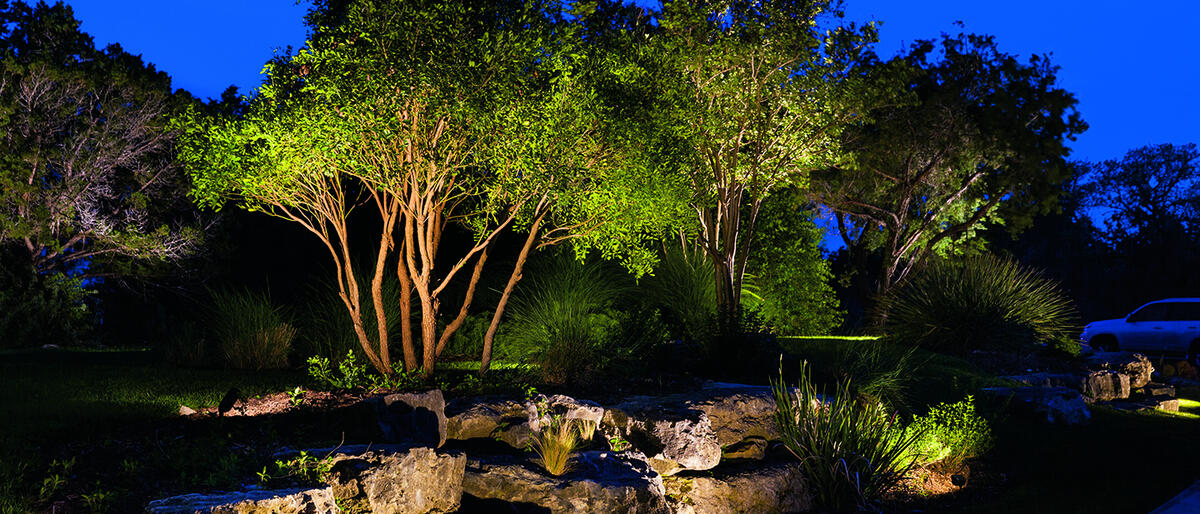Landscape lighting | A must in Portland, Oregon homes!


Often, we see homeowners make the mistake of prioritizing landscape lighting last on the list of design appeal. Properly designed and installed landscape lighting enhances value, beauty and safety to any landscape. Lighting is especially important in Oregon, as we have dark and gloomy days more often than not. We have complied a list of how to use landscape lighting effectively. We believe landscape lighting is a must in Portland, Oregon homes, and are excited to help you create your outdoor oasis.
All too often we see dimly lit walkways with sparsely spaced solar lights. Not only are solar lights ineffective, they are unsightly from a design perspective. The mission of landscape lightning is to set “the mood” of your landscape. Creating a magical nightly outdoor oasis while utilizing the practical element of lighting.
Sitting down and writing a short list of why you want to add landscape lighting will guide your lighting design. Do a lot of outdoor entertaining? Illuminating a fire pit area, sitting area or outdoor kitchen is key to maximizing their use. Perhaps your intention is highlighting a large tudor peak of a Portland home? Or are you steering more toward safety and practicality? Such as lighting dark walk areas. Setting an intention for landscape lighting will ensure you have the basics covered as well as generate ideas you may not have realized are of importance previously. This is an important step in the pre-design phase.
Starting with landscape lighting basics is especially important as it will guide the rest of your design. We recommend at minimum adding lighting for walkways and paths, entryways, driveways, patios, steps, trees and water features.
We always try steering customers toward the LED option. This is for two main reasons, durability/longevity and eco-friendliness. LED lights typically last 50,000 hours and some types even last 100,000! That means, if you ran your lighting all day it would take almost 11.5 years to burn out! LED lights are far superior than halogen in terms of hours of life. LED are also more durable; withstanding weather more effectively than halogen. LED lights use much less energy. LED lights use approximately 329 kwh/year and incandescent use 3285 kwh/year. That is a huge difference in energy consumption. Not only is it better for the environment, it’s better for the wallet. Check out this website for more information on lighting wattage usage and environmental impacts.
EXPERT TIP: LED lights have come a long way since the days of only blue LED’s. They are available in a variety of colors, mimicking the warmer glows seen in incandescent and halogen lights.
Make sure you incorporate lighting timers with your design. Also, take into account the time of year; in winter your timers will need to come on much sooner than the summer.
EXPERT TIP: Have lights scheduled to come on 30 minutes before it gets dark, giving a little wiggle room and avoiding the potential of dark walkways. There are timers available which use your zip code and auto-adjust to your specific sunrise and sunset times through out the year. This automation is a very handy feature to have that we strongly recommend.
The “mood” of lighting will determine the lighting techniques used. For example, using wall washing creates a dramatic effect; while moon lighting gives a romantic effect. Below are commonly used lighting techniques, often used in combination with one another.
Highlighting: The most common technique we use is highlighting. This creates visual interest in the otherwise “lifeless” looking branching structure of deciduous trees. Using this technique will bring a new life to leafless trees.
Silhouetting: This technique can create a dramatic effect with denser objects; creating an illuminated backdrop.
Wall Washing: This technique is exactly what it sounds like. Lighting pointed up and at slight angles, create a dramatic, yet subtle effect.
Moon Lighting: Moon lighting creates a very subtle soft feeling to your Portland landscape, giving the appearance of a full moon shining down on your landscape.
Some common mistakes you want to avoid are adding too many lights. Properly designed (and spaced) lightning is key. Also, adding too many lighting fixtures will wash out the natural light from the moon (and may produce glare), creating a prion-like feeling. When setting up and positioning your lights, avoid shining into neighbors windows, your own or into someone’s face (such as on a path).
Using just the right amount of lights and correct positioning will give an elegant, possibly romantic vibe to your landscape.
When choosing lighting fixtures, focus on fixture quality and the type of light the fixture provides. We recommend a simple black or brown fixture, as its all about the light and not the fixture. Avoid trendy lights and opt for a simple style, this will keep you happy for years to come.
The take-away: There are many factors to think about when deciding on a lighting plan for your landscape. Make sure you take into consideration why you want your lighting. Keeping this in mind will dictate how you proceed with your lighting design. Another important factor to keep in mind is not to focus on the fixture but the type of light bulbs. Lastly, avoid too many or too few lighting fixtures. You want to find the balance of the best spacing for your landscape. If at any point you need assistance with a phase of your project, feel free to contact us so we can create your outdoor oasis together!